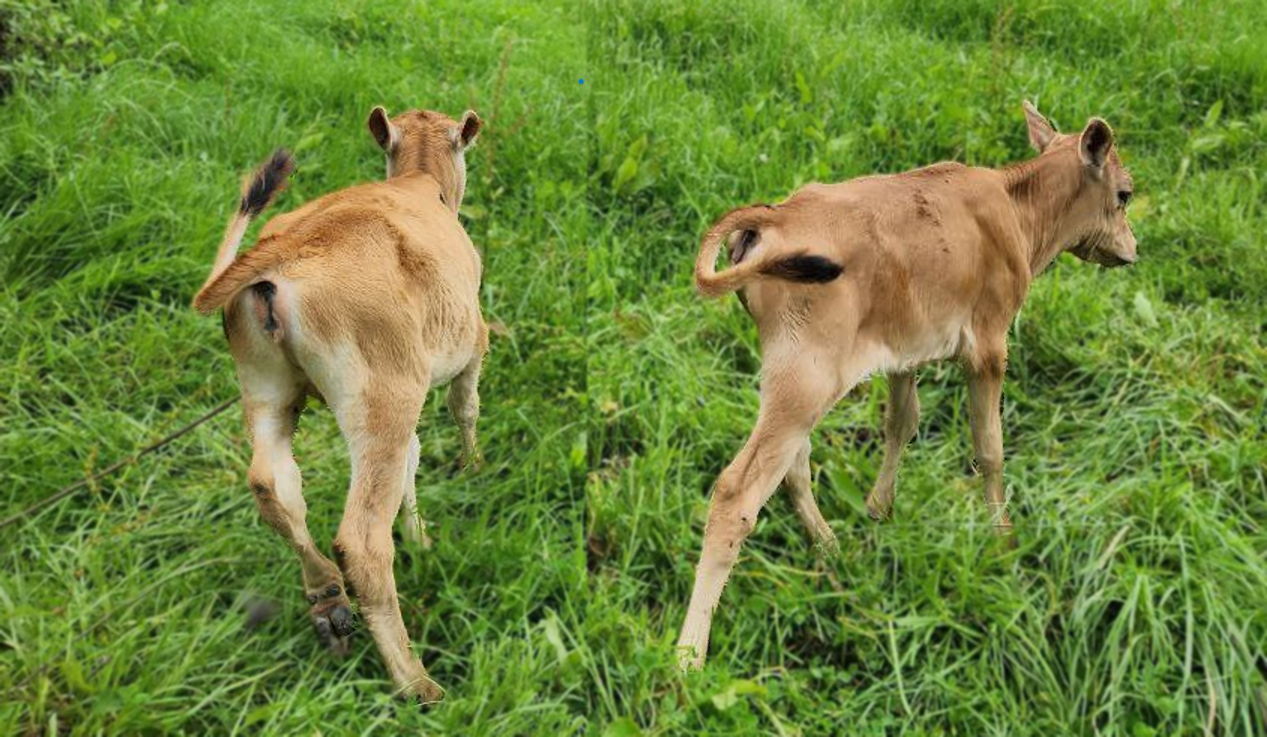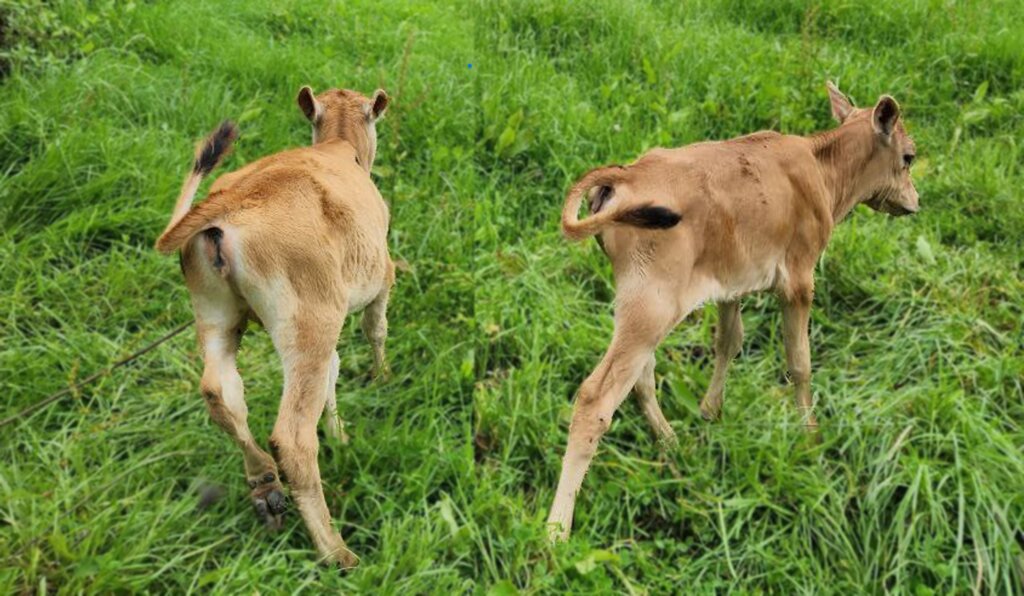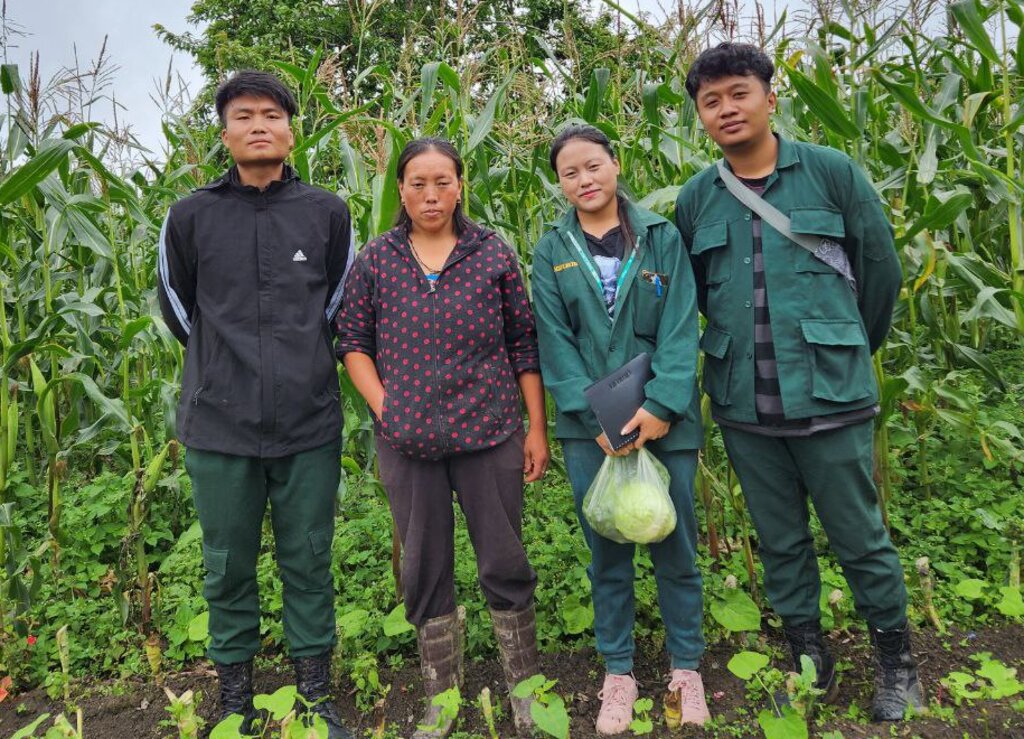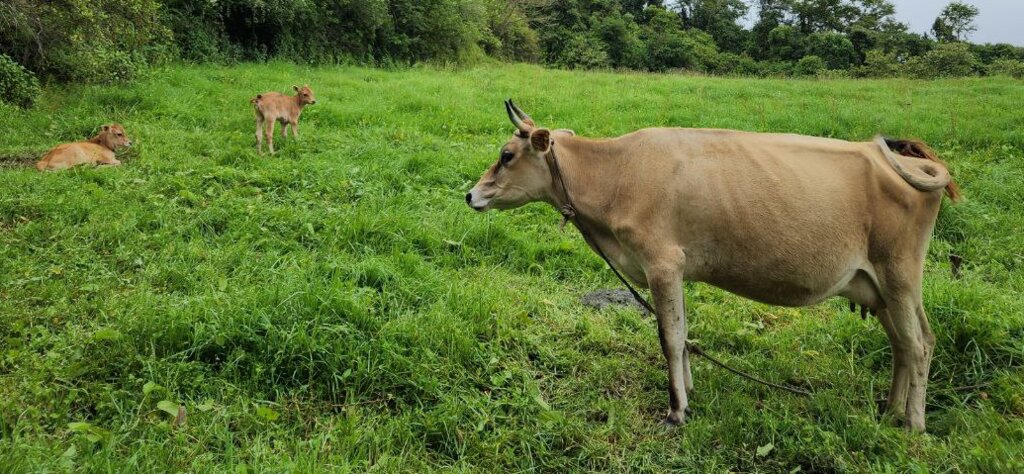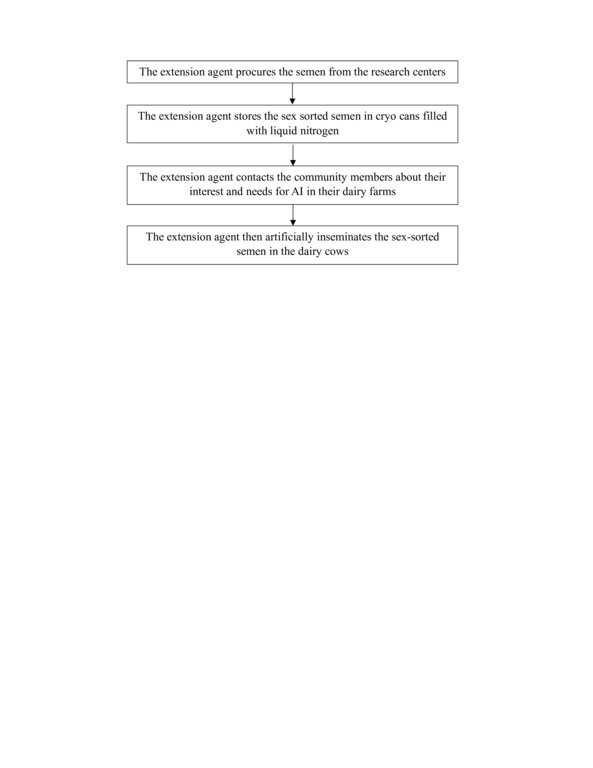Sexed semen technology [Bhutan]
- Creation:
- Update:
- Compiler: ONGPO LEPCHA
- Editor: Kuenzang Nima
- Reviewers: William Critchley, Rima Mekdaschi Studer, Joana Eichenberger
Phomo Yewa Chheyti Yoe Pai Khab Soen Gi Thruel Rig (ཕོ་མོ་དབྱེ་བ་ཕྱེ་ཏེ་ཡོད་པའི་ཁབ་སོན་གྱི་འཕྲུལ་རིག།)
technologies_6823 - Bhutan
View sections
Expand all Collapse all1. General information
1.2 Contact details of resource persons and institutions involved in the assessment and documentation of the Technology
Key resource person(s)
land user:
Pem Tenzin
Tshangkha village
Bhutan
Name of project which facilitated the documentation/ evaluation of the Technology (if relevant)
Strengthening national-level institutional and professional capacities of country Parties towards enhanced UNCCD monitoring and reporting – GEF 7 EA Umbrella II (GEF 7 UNCCD Enabling Activities_Umbrella II)Name of the institution(s) which facilitated the documentation/ evaluation of the Technology (if relevant)
National Soil Services Centre, Department of Agriculture, Ministry of Agriculture & Livestock (NSSC) - Bhutan1.3 Conditions regarding the use of data documented through WOCAT
The compiler and key resource person(s) accept the conditions regarding the use of data documented through WOCAT:
Yes
1.4 Declaration on sustainability of the described Technology
Is the Technology described here problematic with regard to land degradation, so that it cannot be declared a sustainable land management technology?
No
Comments:
The technology is not directly related to land degradation. However, it contribute to sustainable land management practices, as adoption of sexed semen technology pre-determines sex of calf in favor of female progeny (about 90% female and 10% male) that demands good management practices such as development of improved pasture, and improved dairy sheds.
2. Description of the SLM Technology
2.1 Short description of the Technology
Definition of the Technology:
Sexed semen technology produces gender-selected semen for artificially insemination of dairy cows. It ensures a higher proportion of female calves (more than 90%) which will ultimately contribute to the enhancement of milk production in the herd.
2.2 Detailed description of the Technology
Description:
The Artificial Insemination (AI) program, initiated in 1987, has helped AI evolve into a widespread practice for dairy farms across Bhutan, with increasing accessibility due to improved road and transportation networks. The surge in demand for dairy products has positioned AI technology as key in transforming dairy farms from subsistence to market-oriented production systems.
A recent addition to the programme is the use of sexed semen, meaning sorting of semen before artificial insemination. Semen sorting involves categorizing bull semen based on the X and Y chromosomes, thus granting dairy land users control over calf gender. This empowers them to engage in selective breeding, enhancing desired traits and overall quality of dairy production.
Several key activities are integral to this technology:
•Rigorous selection of bulls with desirable traits related to milk production and overall health.
•Collection and preservation of semen from selected bulls.
•Semen sorting technology to separate X and Y chromosome-bearing sperm.
•Artificial insemination of dairy cows by extension agents who use sorted semen.
The benefits are multiple because achieving a higher proportion of heifer calves helps dairy land users to enhance breeding strategies and maintain desired traits within the herd. Economic benefits follow through increased dairy production and improved cattle health.
Land users express satisfaction with the technology and its impact. However, some households report problems with conception rates after AI with sexed semen. Despite these drawbacks, the overall benefits to dairy land users and the industry outweigh the limitations.
2.3 Photos of the Technology
2.5 Country/ region/ locations where the Technology has been applied and which are covered by this assessment
Country:
Bhutan
Region/ State/ Province:
Trongsa
Further specification of location:
Tshangkha, Tangsibji
Specify the spread of the Technology:
- applied at specific points/ concentrated on a small area
Is/are the technology site(s) located in a permanently protected area?
No
Map
×2.6 Date of implementation
If precise year is not known, indicate approximate date:
- 10-50 years ago
2.7 Introduction of the Technology
Specify how the Technology was introduced:
- through projects/ external interventions
Comments (type of project, etc.):
The technology was introduced by the Department of Livestock to increase the likelihood of birthing female cattle and enhance milk production across the country.
3. Classification of the SLM Technology
3.1 Main purpose(s) of the Technology
- improve production
- reduce, prevent, restore land degradation
- preserve/ improve biodiversity
- create beneficial economic impact
- Improves dairy production
3.2 Current land use type(s) where the Technology is applied
Land use mixed within the same land unit:
No

Cropland
- Annual cropping
Annual cropping - Specify crops:
- cereals - maize
- cereals - wheat (spring)
- root/tuber crops - potatoes
- vegetables - leafy vegetables (salads, cabbage, spinach, other)
- vegetables - root vegetables (carrots, onions, beet, other)
Number of growing seasons per year:
- 1
Is intercropping practiced?
No
Is crop rotation practiced?
Yes
If yes, specify:
The crop rotation is normally done with the crops listed above, after the growing season of each crops.

Grazing land
Intensive grazing/ fodder production:
- Cut-and-carry/ zero grazing
- Improved pastures
Animal type:
- cattle - dairy
Comments:
The land is where the manure of the dairy cattles are applied on.
3.3 Has land use changed due to the implementation of the Technology?
Has land use changed due to the implementation of the Technology?
- No (Continue with question 3.4)
3.4 Water supply
Water supply for the land on which the Technology is applied:
- mixed rainfed-irrigated
Comments:
The irrigation is mostly rainfed; however, the availability of water in the community is not an issue.
3.5 SLM group to which the Technology belongs
- integrated crop-livestock management
- improved plant varieties/ animal breeds
3.6 SLM measures comprising the Technology

agronomic measures
- A1: Vegetation/ soil cover
- A2: Organic matter/ soil fertility
3.7 Main types of land degradation addressed by the Technology

biological degradation
- Bc: reduction of vegetation cover
- Bl: loss of soil life

other
Specify:
There is very minimal land degradation.
Comments:
The technology was implemented to address dairy production however, it also contributed to reduced land degradation because many land users have opted for improved dairy cattle by replacing local breeds which were numerous and unproductive.
3.8 Prevention, reduction, or restoration of land degradation
Specify the goal of the Technology with regard to land degradation:
- not applicable
Comments:
This technology is aimed to improve genetic of cattle breed to enhanced dairy production and reduce unproductive cattle population. However, the technology has indirect benefits on sustainable land management through the application of manures, improved housing and pasture development
4. Technical specifications, implementation activities, inputs, and costs
4.1 Technical drawing of the Technology
Technical specifications (related to technical drawing):
Since sexed semen technology was not directly established in the community members, the product of the technology was used in the field through AI. Therefore, a flow chart of how the technology is implemented in the field was not created
Author:
Palden Wangchuk Dorji
Date:
07/07/2023
4.2 General information regarding the calculation of inputs and costs
Specify how costs and inputs were calculated:
- per Technology unit
Specify unit:
Number
Specify dimensions of unit (if relevant):
AI straw
other/ national currency (specify):
Ngultrum
If relevant, indicate exchange rate from USD to local currency (e.g. 1 USD = 79.9 Brazilian Real): 1 USD =:
79.62
Indicate average wage cost of hired labour per day:
600
4.3 Establishment activities
| Activity | Timing (season) | |
|---|---|---|
| 1. | Procurement of sexed semen | Based on indent or the annual requirement at National level |
| 2. | Storage of sexed semen | After procurement until distributed to dzongkhags at Central level |
| 3. | Transportation and Distribution of sexed semen | As per schedule, every 45 days |
| 4. | Storage of semen | semen bank at Veterinary Hospital and AI centre on regular basis |
| 5. | Render Artificial insemination services to farmers by AI technician | Based on request of farmers reporting on animal showing heat signs |
| 6. | Follow up on AI services (monitoring) | 18-22 days, repeat case, monthly report, ad hoc through phone call |
4.4 Costs and inputs needed for establishment
| Specify input | Unit | Quantity | Costs per Unit | Total costs per input | % of costs borne by land users | |
|---|---|---|---|---|---|---|
| Labour | Community AI Technician | person/Day | 2.0 | 1000.0 | 2000.0 | |
| Equipment | Sexed semen AI | per straw | 1.0 | 1500.0 | 1500.0 | |
| Equipment | golves | No | 1.0 | 5.0 | 5.0 | |
| Equipment | AI sheath | No | 1.0 | 16.0 | 16.0 | |
| Equipment | LN2 | litre | 300.0 | 35.0 | 10500.0 | |
| Equipment | LN2 container (55 litre) | No | 2.0 | 25050.0 | 50100.0 | |
| Equipment | Portable AI container (5 litres) | No | 1.0 | 11200.0 | 11200.0 | |
| Equipment | Water boiler (3 litres) | No | 1.0 | 2800.0 | 2800.0 | |
| Equipment | Jug | No | 1.0 | 30.0 | 30.0 | |
| Plant material | Funnel | No | 1.0 | 150.0 | 150.0 | |
| Plant material | Towel | No | 1.0 | 100.0 | 100.0 | |
| Plant material | Flexible Dip stick | No | 1.0 | 2500.0 | 2500.0 | |
| Construction material | AI crates | No | 1.0 | 45000.0 | 45000.0 | |
| Other | Travel | km | 15.0 | 30.0 | 450.0 | |
| Total costs for establishment of the Technology | 126351.0 | |||||
| Total costs for establishment of the Technology in USD | 1586.93 | |||||
If land user bore less than 100% of costs, indicate who covered the remaining costs:
The cost is normally covered by the Royal Government of Bhutan
Comments:
The cost is based on conducting AI for a single dairy cow
4.5 Maintenance/ recurrent activities
| Activity | Timing/ frequency | |
|---|---|---|
| 1. | Storage of the sex sorted semen | When the semen is procured by the extension agent and before conducting AI |
4.6 Costs and inputs needed for maintenance/ recurrent activities (per year)
If land user bore less than 100% of costs, indicate who covered the remaining costs:
The cost is mostly covered by the Royal Government of Bhutan
Comments:
The only maintenance regarding this technology is the storage of the AI straw filled with sex-sorted semen in cryocan filled with liquid nitrogen. The cost is also based on a single AI straw.
4.7 Most important factors affecting the costs
Describe the most determinate factors affecting the costs:
Material cost, heat detection, distance
5. Natural and human environment
5.1 Climate
Annual rainfall
- < 250 mm
- 251-500 mm
- 501-750 mm
- 751-1,000 mm
- 1,001-1,500 mm
- 1,501-2,000 mm
- 2,001-3,000 mm
- 3,001-4,000 mm
- > 4,000 mm
Specify average annual rainfall (if known), in mm:
100.00
Specifications/ comments on rainfall:
The data was used from the National Center for Hydrology and Meteorology from the nearest weather station.
Indicate the name of the reference meteorological station considered:
https://www.nchm.gov.bt/home/pageMenu/906
Agro-climatic zone
- sub-humid
Warm Temperate zone
5.2 Topography
Slopes on average:
- flat (0-2%)
- gentle (3-5%)
- moderate (6-10%)
- rolling (11-15%)
- hilly (16-30%)
- steep (31-60%)
- very steep (>60%)
Landforms:
- plateau/plains
- ridges
- mountain slopes
- hill slopes
- footslopes
- valley floors
Altitudinal zone:
- 0-100 m a.s.l.
- 101-500 m a.s.l.
- 501-1,000 m a.s.l.
- 1,001-1,500 m a.s.l.
- 1,501-2,000 m a.s.l.
- 2,001-2,500 m a.s.l.
- 2,501-3,000 m a.s.l.
- 3,001-4,000 m a.s.l.
- > 4,000 m a.s.l.
5.3 Soils
Soil depth on average:
- very shallow (0-20 cm)
- shallow (21-50 cm)
- moderately deep (51-80 cm)
- deep (81-120 cm)
- very deep (> 120 cm)
Soil texture (topsoil):
- coarse/ light (sandy)
Topsoil organic matter:
- high (>3%)
5.4 Water availability and quality
Availability of surface water:
good
Water quality (untreated):
good drinking water
Water quality refers to:
surface water
Is water salinity a problem?
No
Is flooding of the area occurring?
No
Comments and further specifications on water quality and quantity:
In accordance with the land users, the quantity of water is more than enough and the quality of the water is also very good compared to the past.
5.5 Biodiversity
Species diversity:
- high
Habitat diversity:
- high
Comments and further specifications on biodiversity:
Since the land user practices crop rotation and grows different types of crops throughout the year, the species diversity is high.
Less forest grazing because land users have replaced unproductive local breeds with improved breeds like Jersey, Holstein Friesian, or cross breeds.
5.6 Characteristics of land users applying the Technology
Sedentary or nomadic:
- Sedentary
Market orientation of production system:
- subsistence (self-supply)
Off-farm income:
- less than 10% of all income
Relative level of wealth:
- average
Individuals or groups:
- individual/ household
Level of mechanization:
- mechanized/ motorized
Gender:
- women
Age of land users:
- middle-aged
5.7 Average area of land used by land users applying the Technology
- < 0.5 ha
- 0.5-1 ha
- 1-2 ha
- 2-5 ha
- 5-15 ha
- 15-50 ha
- 50-100 ha
- 100-500 ha
- 500-1,000 ha
- 1,000-10,000 ha
- > 10,000 ha
Is this considered small-, medium- or large-scale (referring to local context)?
- medium-scale
Comments:
Total land owned: 5 acres
Total cultivated land: 1 acre
Remaining lands were either fallow and some of areas of the land were used as pasture land for their cattle to graze.
5.8 Land ownership, land use rights, and water use rights
Land ownership:
- individual, titled
Land use rights:
- individual
Water use rights:
- open access (unorganized)
Are land use rights based on a traditional legal system?
Yes
Specify:
The traditional legal system in our country is as per the land act and rules and regulations which dictate the land use in the country.
5.9 Access to services and infrastructure
health:
- poor
- moderate
- good
education:
- poor
- moderate
- good
technical assistance:
- poor
- moderate
- good
employment (e.g. off-farm):
- poor
- moderate
- good
markets:
- poor
- moderate
- good
energy:
- poor
- moderate
- good
roads and transport:
- poor
- moderate
- good
drinking water and sanitation:
- poor
- moderate
- good
financial services:
- poor
- moderate
- good
6. Impacts and concluding statements
6.1 On-site impacts the Technology has shown
Socio-economic impacts
Production
fodder production
Quantity before SLM:
The cattle were normally grazed in the forest, so no fodder were produced.
Quantity after SLM:
Some of the land that were left fallowed were used for fodder production.
fodder quality
Quantity before SLM:
Local cattles can feed on wild fodder grasses and trees
Quantity after SLM:
Improved cattles require quality fodder so they started growing improved fodders species like Super Napier grass, Napier grass, etc.
animal production
Quantity before SLM:
5 liters of milk were produced from each dairy cow every day
Quantity after SLM:
15 liters of milk are produced by each dairy cow everyday
Comments/ specify:
The quantification was based on the amount of milk produced.
production area
Quantity before SLM:
5 acres of cultivated land
Quantity after SLM:
1 acre of cultivated land
Comments/ specify:
The land user now focuses mostly on dairy production and has converted some of the lands into pasture for grazing purposes while the rest has been left fallow. This is due to the absence of labour in the household.
Income and costs
expenses on agricultural inputs
Comments/ specify:
This is due to the decrease in the cultivated land.
farm income
Comments/ specify:
Due to the increase in dairy production, the land user is greatly benefited from it.
workload
Comments/ specify:
Since the land user focuses primarily on dairy, the amount of workload has relatively increased compared to the past, where she would only focus on agriculture, only.
Socio-cultural impacts
food security/ self-sufficiency
Quantity before SLM:
Mostly consumed food they produced in their household.
Quantity after SLM:
Diverse food products are available, together with dairy products.
Ecological impacts
Biodiversity: vegetation, animals
plant diversity
Quantity before SLM:
Maize, wheat and potatoes were the only primary crops grown.
Quantity after SLM:
Maize, wheat, potatoes and several other cole crops and legumes are now cultivated by the land users.
6.2 Off-site impacts the Technology has shown
impact of greenhouse gases
Quantity before SLM:
more than 30 cattles including dairy cows and bulls
Quantity after SLM:
around 15 dairy cows
Comments/ specify:
There is decrease in the number of cattle and they are mostly female.
6.3 Exposure and sensitivity of the Technology to gradual climate change and climate-related extremes/ disasters (as perceived by land users)
Gradual climate change
Gradual climate change
| Season | increase or decrease | How does the Technology cope with it? | |
|---|---|---|---|
| annual temperature | increase | well | |
| annual rainfall | decrease | well |
Climate-related extremes (disasters)
Meteorological disasters
| How does the Technology cope with it? | |
|---|---|
| local rainstorm | well |
| local thunderstorm | well |
| local hailstorm | well |
Biological disasters
| How does the Technology cope with it? | |
|---|---|
| epidemic diseases | moderately |
| insect/ worm infestation | moderately |
Comments:
This rating is based on the cattle produced by the technology since the technology itself is not impacted greatly by the change in climate and weather.
6.4 Cost-benefit analysis
How do the benefits compare with the establishment costs (from land users’ perspective)?
Short-term returns:
positive
Long-term returns:
positive
Comments:
The benefits of the technology are very high. The recurrent cost of AI is very low as it is provided for free by the Royal Government of Bhutan.
The land users also get the desired sex of the cattle they want (female cattle).
The return they get from improved cattle is very high(high milk yield).
6.5 Adoption of the Technology
- > 50%
If available, quantify (no. of households and/ or area covered):
28 households
Of all those who have adopted the Technology, how many did so spontaneously, i.e. without receiving any material incentives/ payments?
- 0-10%
Comments:
The technology can only be implemented by the extension agent since the sexed semen is only procured by them and artificial insemination is also done by the extension agent.
6.6 Adaptation
Has the Technology been modified recently to adapt to changing conditions?
No
6.7 Strengths/ advantages/ opportunities of the Technology
| Strengths/ advantages/ opportunities in the land user’s view |
|---|
| Produces desirable traits of offspring |
| Improved breed quality |
| Enhances dairy production |
| Produces female cattle |
| Manure from the cattle is used for revitalising the farmland. |
| Strengths/ advantages/ opportunities in the compiler’s or other key resource person’s view |
|---|
| It helps improve the land users livelihood by benefiting them economically. |
| Sexed semen technology produces desired sex cattle which also reduces the recurrent cost of doing AI again and again to get desired sex cattle. |
| Sexed semen technology can ultimately reduce number of unproductive cow which can reduce land degradation and reduce greenhouse gas emmission. |
6.8 Weaknesses/ disadvantages/ risks of the Technology and ways of overcoming them
| Weaknesses/ disadvantages/ risks in the land user’s view | How can they be overcome? |
|---|---|
| Sometimes the cattle do not conceive even after insemination. | The possibility of a cow not conceiving after an AI is very low, but it is recommended that the land user consult with the livestock agent or conduct AI again. |
| Weaknesses/ disadvantages/ risks in the compiler’s or other key resource person’s view | How can they be overcome? |
|---|---|
| Sexed semen technology reduces the male population, getting quality breeding bull will be difficult in future. | Allow the dairy cow to mate naturally once in their lifetime |
| Semen produced from the technology may become ineffective during the sorting procedure. | Follow appropriate procedures and double-check equipment. |
7. References and links
7.1 Methods/ sources of information
- field visits, field surveys
One household
- interviews with land users
One individual
When were the data compiled (in the field)?
07/07/2023
7.2 References to available publications
Title, author, year, ISBN:
Guar et al. (2021). Sex Sorted Semen -Methods, Constraints and Future Perspective. Veterinary Research International, 8, 368-375.
Available from where? Costs?
https://www.researchgate.net/publication/354631046_Sex_Sorted_Semen_-Methods_Constraints_and_Future_Perspective
Title, author, year, ISBN:
Singh et al. (2019). Sexed semen technology in cattle: A revolutionary technique in Indian dairy industry. 9, 946-950
Available from where? Costs?
https://www.researchgate.net/publication/337919029_Sexed_semen_technology_in_cattle_A_revolutionary_technique_in_Indian_dairy_industry/citation/download
Title, author, year, ISBN:
Department of Animal Husbandry and Dauty. (2020). Accelerated Breed Improvement Programme -Using sex sorted semen for getting assured pregnancy. Govt. India
Available from where? Costs?
https://dahd.nic.in/sites/default/filess/Guidelines%20for%20sex%20sorted%20semen%20v3.pdf
Title, author, year, ISBN:
Butler et al. (2015). The importance of recording in establishing the value of sexed semen to dairy farmers. The Irish Agriculture and Food Development Authority
Available from where? Costs?
https://www.icar.org/wp-content/uploads/2015/09/A2-Butler_PPT.pdf
Title, author, year, ISBN:
Kumar et al. (2017). Sexed Semen Technology in Cattle. Indian Journal of Animal Health, 56(2), 157-168.
Available from where? Costs?
http://ijah.in/upload/snippet/145_53.pdf
Title, author, year, ISBN:
Tshering, L. & Tamang, N. B. (2018). Decades of Artificial Insemination: Bittersweet Experiences on Cattle Breeding in Bhutan. Bhutan Journal of Animal Sciences, 2(1), 1-6.
Available from where? Costs?
https://www.researchgate.net/publication/353317476_DECADES_OF_ARTIFICIAL_INSEMINATION_BITTERSWEET_EXPERIENCES_ON_CATTLE_BREEDING_IN_BHUTAN
7.3 Links to relevant online information
Title/ description:
TASHI: The First Woman Community AI Technician in the East. /Dzongkha language/
URL:
https://www.youtube.com/watch?v=gk_iXm94ZQQ
Title/ description:
Koufouku International Limited - A Link in the Dairy Value Chain in the East
URL:
https://www.youtube.com/watch?v=JLB_3fdz3ag
Links and modules
Expand all Collapse allLinks
No links
Modules
No modules


